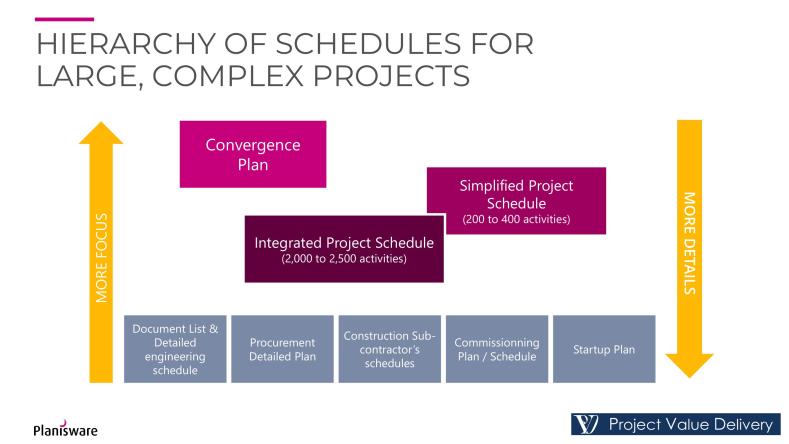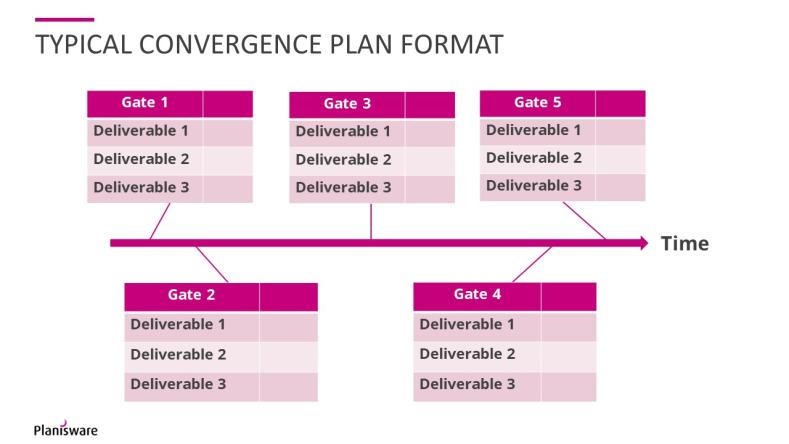It is absurd to believe that a single map could be used for all phases of navigation, it is absurd to believe that a single schedule with the finest level of detail will do the job on a large Project – and for all contributors.
It is absurd to believe that a single map could be used for all phases of navigation, it is absurd to believe that a single schedule with the finest level of detail will do the job on a large Project – and for all contributors. - Jeremie Averous, Advanced Scheduling Handbook for Project Managers
We can’t all use the same universal map to accomplish our tasks.
Consider a pilot, for example. They wouldn’t use a street map to fly from one continent to another - they’d need something with a larger scale and less detail. Much like a pilot, project managers need an overview of the whole journey when orchestrating large, complex projects. If you rely on an overly detailed schedule, the bigger picture can get lost and you may end up deviating from your desired outcomes.
That said, you’ll need other maps that serve other purposes too.
This time around, consider a hiker. They need more detail when plotting their route; where’s the easiest trail? Where are the rocky cliffs and rivers they should avoid? You can think of your project teams as hikers. They need a more granular level of detail in order to complete deliverables.
In a similar way, when managing a large, complex project - which can have thousands of tasks and hundreds of dependencies - the project coordinator will need a high-level overview of the schedule, but the teams carrying out the work might need more detailed schedules; and the two schedules need to be kept in sync.
So, in order to improve the success of your large, complex map, a set of interconnected “maps” or schedules that provides each stakeholder with the level of detail they need can make all the difference.
In this blog post, we use Jeremie Averous’s book, Advanced Scheduling Handbook for Project Managers, as a basis for discussing project schedules.
Project Scheduling For Each Use Case
A good way to start breaking down your projects is in three levels, each of which caters to an intended use case and users:
Strategic – the bird’s eye view. Schedules at this level provide a long-term overview. They allow you to make financial, contractual, and resource decisions that impact all aspects of the project. This is your ideal level of focus as a project manager.
Project coordination – where everything comes together. On the project coordination level, you’ll consolidate information from all respective contributors - construction, engineering etc. This information can then be used for analyzing, trending, and reforecasting.
Operational – the fine detail. Only the people on the ground, carrying out specific tasks, need this level of detail. Higher-level decisions are turned into step-by-step plans, for the teams that will deliver them. Schedules at the operational level also allow data to be fed back to management, so progress can be measured and managed.
Hierarchy of Schedules For The Project Manager

Complex projects require a hierarchy of schedules that cascade from less detailed to highly detailed.
Take the HS2 high-speed railway in the UK as an example. Large-scale infrastructure projects like that require huge amounts of coordination and collaboration. Beyond sourcing funding and navigating risk assessments, the HS2 project requires a mass orchestration of materials, construction workers, and suppliers. Not to mention the juggling of priorities, risks (such as bad weather or supply chain issues), and resource shortages. There are many moving parts. And, without a sophisticated approach to project scheduling, it’s impossible to manage them all.
Multiple schedules allow for multiple perspectives and ensure everyone can access the correct level of detail to do their job.
Let’s now discuss the purpose, function, and benefits of each type of schedule, taking inspiration from Averous’s book:
Simplified Project Schedule
Producing a simplified project schedule requires in-depth knowledge of the project’s main milestones. That means, as a project manager, you need to lead on this. The completed schedule will reflect these milestones in 200-400 key activities, so it’ll require your discernment on what to include.
Get the whole project team involved in producing this schedule with you by arranging a workshop at the start of the project. Producing the simplified project schedule that way will give everyone a better understanding of the success factors.
All tasks within this schedule must be fully and logically linked. Use it for scenario planning, scheduling statistical analysis, and communicating with stakeholders. If you need to negotiate with management for extra time on a project, this will support you.
Convergence Plan
This is your project overview, highlighting points where people, equipment, and deliverables must come together for the project to progress. For example, if you’re a car manufacturer building a car, there will be convergence points where you need the right materials and people at the same place, at the same time. If you don’t have the wheel hubs and wheel bearings to hand and your workers need to fix the wheels to your cars, you’re in trouble.
It’s important to create this plan first, within a few days of mobilization. It should include no more than 100 – 150 deliverables for the whole project.
Don’t underestimate the importance of this plan. Consider the car manufacturer; without the wheels on the car, they may delay other aspects of the build. This has a roll on effect, causing disruption and costly delays. The convergence plan helps you to avoid this. It’s a graphical representation of the key points, that can be monitored as part of visual management and used to show other people within the organization, at a glance, where the project stands.

Transparency regarding workstreams, convergence points, and key deliverables:
- Allows everyone to track progress and respond accordingly.
- Helps people identify potential risks and sticking points.
- Helps in capacity planning - If you know when a convergence point is happening (and you know you’ll be in big trouble if it doesn’t happen), you’ll be better equipped to allocate the right resources at the right time.
Integrated Project Schedule
This schedule drills down further into the detail. It’s your go-to schedule for forecasting and decision-making, covering the entire project execution scope in 2,000 – 2,500 activities.
The trick is to include enough detail about every trade and functional requirement (procurement, construction, commissioning, etc), so that those trades and functions can use this schedule as a starting point for more detailed planning.
But don’t include too much detail — you must anticipate changes as you go, and scheduling too far in advance can affect your adaptability. As such, your project management team should update the integrated project schedule on at least a monthly basis to reflect the current progress of the project.
Make sure the integrated project schedule focuses on the interfaces between the different project functions. For example, where does the progress of a construction project impact subsequent engineering work?
Detailed Functional Schedules
We get down to the particulars here. Detailed functional schedules don’t cover the entire scope. They dig into one particular area of the project in detail — hence the name. For example, one area may be the electrical system. In the schedule, you might write a list of activities, dates, and deliverables related to this one task.
These schedules might be linked locally, or you may decide that’s not necessary. For example, an engineering firm with a complex project to deliver might produce a fully linked, highly detailed engineering schedule. In another area of the project, a simple list of key dates could suffice.
Functional schedules are generally produced by the people who need them; the construction company produces the construction schedule, and so on. These schedules can be updated on a rolling basis. There should be plenty of detail for imminent tasks, but there can be less for more distant ones.
You’ll plot and monitor the milestones where these functions converge on the integrated project schedule.
Best Practices For Coordinating Interconnected Schedules
“From the onset of the Project, it is essential to have a clear and unambiguous schedule hierarchy that will be used throughout the project.” Jeremie Averous
Complex projects require a more sophisticated approach to scheduling as they typically involve more moving parts — more deliverables, more suppliers to work with, more resources.
For these projects, one map won’t do. You need to create interconnected plans that support your project teams across the board.
When coordinating these schedules, Averous offers the following tips:
- Maintain regular communication - scheduling teams should have weekly, or even daily, meetings.
- Establish a culture of continuous reporting and data capture - it may help to use a project management software to support this.
- Make sure your integrated project schedule stays within 2000-2500 words - this document is the most important point of reference for your project managers and you don’t want them to get lost in detail.
- Avoid variance between schedules. For example, detailed functional schedules — that may sit with third parties — could emphasize different project milestones to your simplified schedules. Where the variance is absolutely unavoidable (it happens), the project management team must maintain their overview throughout, so a single, truthful, integrated project schedule is essential.
- Make sure your integrated project schedule stays within 2000-2500 words - this document is the most important point of reference for your project managers and you don’t want them to get lost in detail.
- Avoid variance between schedules. For example, detailed functional schedules — that may sit with third parties — could emphasize different project milestones to your simplified schedules. Where the variance is absolutely unavoidable (it happens), the project management team must maintain their overview throughout, so a single, truthful, integrated project schedule is essential.

